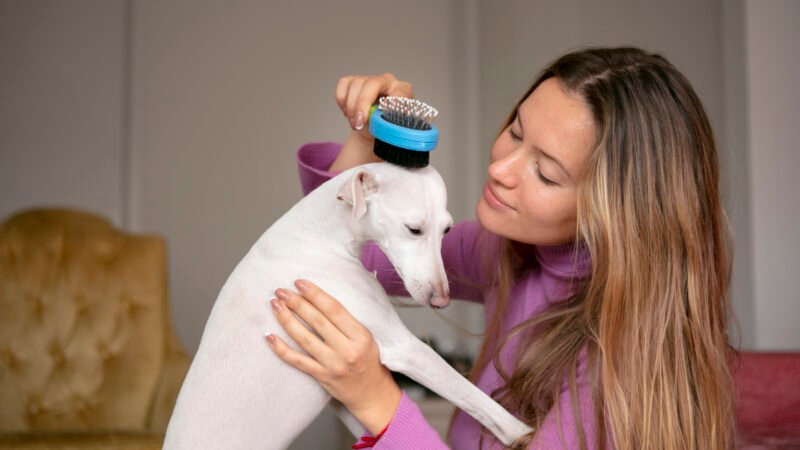7 Essential Steps to Beat Dog Fleas
The Complete Guide to Prevention, Care & Cleaning

Fleas: Every Dog Owner’s Nightmare
Lightning‑fast reproduction:A single female flea can lay up to 50 eggs per day, creating a new generation in just one week.
Relentless reinfestation:Even after treating your dog, flea eggs and larvae hiding in carpets, bedding, and upholstery will hatch if not fully cleaned.
Serious health risks: Heavy infestations can cause anemia, intense itching, secondary bacterial infections—and even transmit tapeworms or Lyme disease.
The 7 Essential Steps for Flea Prevention & Control
Monthly Dosage|Veterinarian Recommended Flea Medication
Use a vet-approved topical spot on or oral treatment containing active ingredients like ivermectin or fipronil for at least 30 days of protection.
Dose precisely according to your dog’s weight—missing a month can drastically reduce effectiveness.
Twice Weekly|Fine Tooth Flea Comb Sessions
Comb from head to tail with a dedicated flea comb, paying close attention to behind the ears, armpits, and groin.
Drop any captured fleas and debris into soapy water to prevent escapes.
Daily|Anti Itch Spray or Medicated Soak
At the first sign of scratching, redness, or irritation, apply an antibacterial/anti inflammatory spray (containing ingredients like diphenhydramine or hydrocortisone).
For moderate infestations, give a medicated bath 1–2 times per week using sulfur soap or miconazole based formulas to eliminate parasites.
Weekly|Whole House Deep Cleaning
Bedding & Blankets: Machine wash in water ≥140°F (60°C) and tumble dry on high.
Carpets & Upholstery: Use a steam cleaner or pet safe insecticide spray, focusing on cracks, baseboards, and corners.
Bi Monthly|Indoor Environment Treatment
Apply a pet safe indoor spray (with pyrethroids or imidacloprid) to floors, under furniture, and along walls.
Wait at least four hours before letting your pet back in to ensure chemical residues dissipate.
Every Bath|Proper Flea Control Bath Routine
Pre wet with warm water: Around 100°F (38°C) to avoid skin shock.
Use a flea specific shampoo: Look for fipronil or diatomaceous earth formulations, lathering for a full five minutes.
Rinse thoroughly: Any soap residue can further irritate the skin.
Dry on low heat or air dry: High heat can damage the skin barrier.
Ongoing Monitoring|Quarterly Vet Checkups
Schedule a full physical exam—including skin scrapings and blood work—every three months to detect fleas or other parasites early.
In high risk seasons (spring and summer), consider shortening treatment intervals to every three weeks.
Bonus Tips for Lasting Protection
Boost Skin Health: Supplement with omega 3 fish oil and vitamin E to strengthen your dog’s natural barrier.
Reduce Stress: Regular exercise and playtime lower anxiety—dogs under stress scratch more, risking secondary infections.
Choose the Right Bedding: Waterproof, anti mite materials make laundering and disinfection easier.
BreedSpecific Flea Prevention Recommendations
1.Short Haired Breeds (e.g., Boxers, Dachshunds)
Medication: Topical spot ons spread more evenly—apply once monthly directly to the skin.
Comb Frequency: Quick flea comb sessions weekly catch problems early.
Home Cleaning Focus: Short hair sheds less but trapping of skin flakes in carpets means regular vacuuming of dog favorite spots.
2.Long Haired Breeds (e.g., Golden Retrievers, Samoyeds)
Preventive Baths: Every 1–2 months, use a flea shampoo with fipronil or diatomaceous earth to reach the hair roots.
Daily Brushing: After outdoor walks, detangle with a wide tooth comb then follow up with a fine tooth flea comb.
Targeted Trimming: Trim paw pads, groin, and under tail hair every 4–6 weeks to reduce hiding spots.
3.Sensitive Skinned Breeds (e.g., French Bulldogs, Pugs)
Gentle Treatments: Use unscented, hypoallergenic spot ons to avoid irritation.
Cool Temperature Baths: Keep water below 90°F (32°C), and apply a soothing anti itch spray afterward.
Daily Inspection: Check skin folds for redness and treat promptly with a tear free antimicrobial spray.
4.Puppies & Senior Dogs
Puppies (< 6 months): Extend topical treatment intervals to every 6 weeks; pair with gentle combing.
Seniors (> 7 years): Weakened skin barrier benefits from a combined approach of spot on plus monthly medicated bath and extra fish oil supplements.
5.Working & Active Dogs (e.g., Herding Dogs, Police Dogs)
Frequent Treatment: Shorten spot on intervals to every 3 weeks for heavy outdoor exposure.
Post Work Cleanup: Wipe down legs, belly, and neck with pet safe wipes after each training session.
Gear Maintenance: Wash harnesses and leashes in hot water regularly to eliminate hidden parasites.
6.Small vs. Large Breeds
Small Breeds (e.g., Chihuahuas, Pomeranians): Precise spot on dosing plus an anti itch spray keeps discomfort minimal.
Large Breeds (e.g., Great Danes, Saint Bernards): In addition to monthly spot ons, consider adding a flea collar for continuous protection around the neck and shoulders.
Fleas not only torment your dog but jeopardize your entire household. By following these 7 essential steps—from targeted medications and combing routines to deep cleaning and professional checkups—you’ll eradicate fleas for good. Spend just five minutes a month, and make your home a flea free zone!
